#Contraflow Collective
Explore tagged Tumblr posts
Text
Doozer and Djar One ft. DJ Specifik - Space Bear Clique [Video]
MC Doozer (Critically Ill, Contraflow Collective) and French producer Djar One drop the latest single from B-Line Recordings entitled Space Bear Clique. Humorous or serious take your pick, the track verges into an older vibe and cuts from DJ Specifik complete the piece. Mixed and mastered by: Djar OneFilmed and edited by: Tempo…
#B-Line Recordings#Contraflow Collective#Critically Ill#Djar One#Space Bear Clique#Specifik#Tempo Media#The Doozer
0 notes
Text
Liza Burkin
Against the Grain: Safety Analysis and Design Guidance for Shared Contraflow Bike Streets
Building on methods and examples from Europe, Burkin's thesis is a groundbreaking study about the safety and effectiveness of one-way contra-flow bike Streets in North America. Using original field work to gather data, the thesis forms a foundation for this important street type to be included in nationally recognized street design guides. The Esri Story Map format makes the thesis engaging and is perfect for illustrating before and after street changes and video documentation of specific vehicle/ bike interactions.
More details can be found on the UEP Practical Visionaries Blog
Abstract
This thesis explores the idea that while one-way streets are primarily meant to divert and control motor vehicle traffic, they should not limit the travel direction of bicyclists in a low-speed, low-volume context. With thoughtful design interventions, people riding bikes and driving cars can safely share space traveling in opposite directions – even on streets that do not have space for dedicated contraflow bike lanes.
An extensive literature review, examination of six case studies, and video analysis from one street in Somerville, Massachusetts provide evidence that shared contraflow bike streets are a safe and useful street design for local roadways – especially when needed for bicycle boulevards or neighborhood greenway routing. Video data collected before and after the opening of legal shared contraflow in Somerville reveal that ridership and safer positioning on the street increased, while sidewalk riding and close passing decreased.
Additionally, this paper provides design guidance for different levels of shared contraflow interventions, recommends citywide contraflow policies rather than street-by-street application, and proposes public engagement and prioritization methods for studying, redesigning, and implementing shared contraflow bike streets. The project demonstrates how the absence of standards and guidance around these types of streets results in a lost opportunity for low-stress bike networks that serve people of all ages and abilities.
#2019#MA#Chase#LizaBurkin#AgainstTheGrainSafetyAnalysisAndDesignGuidanceForSharedContraflowBikeStreets#Safety#Analysis#Design#Contraflow#Bicycles#Streets#Transportation
2 notes
·
View notes
Photo

"Good luck," said the governor to east Texas as he flew away. East Texas turned back to its preparations for receiving Harvey. While along the border, our mid-city mountain range divides the city center into east–west and north–south microclimates that cause differing rates and amounts of rain, wind, fog, and cloud cover. This afternoon, it rained above Polk School. At 4:30, the skies clouded up at UTEP. Later, a terrific cloudburst caught up to us at Charlie Clark Nissan around 5. Rain collected along Doniphan by 5:30 and inched toward the railroad tracks and salt cedar. Most likely Sam's clinic near Talbot will have a wading pool instead of a parking lot by Monday morning. Several summers ago his nurse told me the water pooled from his door and car park to the carved door and gate vendor across Doniphan. Pictures here from 2005 and 2006 show our arroyo and how much rain collected during the 2006 100–year flood. Mountain rains channeled down the hills and collected. From there, it traveled on to the nearby water treatment plant. At its fullest, river birds found their way from the Keystone to the ponds in the foothills. For a while we had ducks and terns flying above the house. The toads awoke and sang for days. Until you've waited long hours on I10 by Piedras, stuck in traffic for the contraflow to be moved into place, it's all just water that soon moves down to the river. Good luck to Austin, Corpus, Houston, San Antonio, parts in between, and all the ships at sea. #elpaso #elchuco #lafrontera #monsoon (at Chaparral Park North (Foxes) Arroyo)
1 note
·
View note
Text
Thursday 7th/Monday 11th September – Mugello, Italy
Italy – what can I really say about it?
Let’s start with Thursday, which was really entirely eaten up with travelling. We got a good early start on Thursday morning, which turned out to be just as well, because the M40 was grindingly slow after a “police incident” (explosives found in the woods alongside the road apparently) and we had to drag the long way round to Robert’s. Anyway, once we were all in my car we made remarkably good progress to Gatwick and only arrived a few minutes late at the car parking drop off point. Once they had taken the car away we proceeded to the not-very-fast bag drop and finished the check in process I’d started the day before. We checked in online as soon as that option was available and managed to snag the emergency exit row. The bag drop and security took about an hour, but we still had enough time to go to the Seafood Bar for lunch, and to do some shopping before we called at Chez Gerard for coffee. By then, a delay of one hour to our flight had been announced, so we were in no hurry. The flight itself was unremarkable, though we were glad we’d eaten before hand. The industrial tuna mayonnaise sandwich was truly nasty (one bite was enough) and the chicken sandwich was no better. I handed them back with one small bite out of each… The stewardess had the grace to admit several other people had complained too…
Anyway, we made it to Bologna eventually, only to arrive at the car hire desk just behind Trevor Carlin and Martin Stone who were muttering that we might be late, but at least we had luggage, which is more than they did! We collected the car, plugged in Doris, and set off on to the Italian highways. The A1 motorway would take us most of the way to Mugello, though it wasn’t the easiest of drives. The road itself is being rebuilt, pretty much, as they try and straighten it. This means that some bits are very narrow, with contraflows, while the completed bits go straight through the mountains in a series of long tunnels. Outside the tunnels the weather was vile (foggy, wet, low visibility) and inside Doris the Sat-Nav wouldn’t talk to us! We finally made it to the hotel, which turned out to be about 10 miles up a twisting mountain road, around 9.15.
The restaurant was shut, so they sent us back down the hill a short distance to Da Gianni, which was a terrific little family-run place, where I had prosciutto and then grilled rabbit with spinach, and we drank a number of bottles of the local red wine, before we hit the biscotti and vin santo instead of dessert. Total cost? Around €25 a head. We lurched back to the hotel full and content, and unpacked quickly before heading for bed.Friday was find the circuit day. It was, as advertised, about 25 minutes away, but needless to say it wasn’t quite as easy as we could have hoped. There was a certain amount of driving round in circles in Scarperia while we tried to locate the accreditation office, but we did eventually track it down, and then the circuit entrance, which at the moment is down a very narrow country lane (though to be fair they do seem to be building a new access road which looks as if it will take the strain off the town, and speed up access generally). We arrived just in time for testing, to discover that all press offices should be like this! There were 3 or 4 electric sockets per desk, along with a bank of 8 screens every two rows. The wifi access was spotty but was eventually fixed, and pretty much everything except the toilets was spot on. The toilets, to be fair, were clean and shiny, but they were also the so-called Turkish toilets where you stand over a hole in the porcelain. If you wanted to sit down, you had to use the disabled toilets, which didn’t lock… That led to most of the women queuing for the disabled toilets, usually with a friend in tow to guard the door! Still, it’s otherwise a stunning facility, and the drivers mostly loved it.
Dumbest question of the day? From someone who really should have known better… Chris Weller to Mika Salo, clearly forgetting that his ex-driver was once employed by Ferrari and this is a Ferrari test facility… “Have you been here before?” Mika’s answer? “Yes, every day for x months…” He was on fine form, as were Bas Leinders and Peter Kox, the former admitting that the car’s getting a lot better now the team have realised that he knows a thing or two about getting the best out of a race car, and the latter feeding us coffee, but only if we didn’t mind plastic cups, because he has to do the washing up himself! Luckily, the weather perked up as the day wore on, so we left the circuit early and headed off into Scarperia, where we wandered round a bit looking at medieval buildings before we set off back to the hotel, looking for a gelateria on the way. It proved elusive but we finally tracked one down on the outskirts of Barberino del Mugello, which made us all happy.
That evening we headed back to Da Gianni for dinner, and this time I had pasta with wild boar sauce, and would have had pigeon, but somehow my order went missing, and I got the vegetable, but the piccione never showed up. It was probably not a bad thing really. By the time we asked about it, I’d kind of lost interest so the idea that it would take another 30 minutes meant I decided not to bother. The others seemed to enjoy their steaks and/or rabbit and the frittura mista were good even without the accompanying main course. Once again I couldn’t have managed a dessert, so we hit the biscotti again, before retiring to bed.
Saturday started ludicrously early, because qualifying started at 9. The hotel breakfast room was packed to the gunnels with tourists (at 7.30? Who on earth breakfasts at 7.30 on holiday?) so we went straight to the track instead. For what happened during the day, anyone who is interested can read the reports. Mostly the weather got steadily worse and by the time we made it back to the hotel it was looking like it might never stop raining. We decided we wanted to eat somewhere else this time, so Cassandra (who speaks better Italian than the rest of us) asked for a recommendation. The hotel people suggested a restaurant in Prato, on the edge of Florence, called the Veranda. They even gave us directions (which didn’t help). They said to turn left at the first roundabout, but neglected to mention (or didn’t know) that it’s now the second roundabout as a new one has been added. The upshot was a misguided tour of Prato in the pouring rain before we finally found the place. Once again it was a family-run place, and it was heaving with locals. The trouble was we were wedged in under a TV set that was blaring away showing a football match, which meant conversation was very difficult, and they kept messing up the orders. I had a very good starter of seafood risotto, but didn’t think much of my main course, veal with mushrooms, as the sauce was very glutinous, and not in a good way either. In addition, we were between the kitchen and the rest of the room and anyone wanting to get to the toilets also had to squeeze past us. All in all, not an experience I’d care to repeat, even for a risotto as good as that.
Getting back to the hotel was interesting too, because the restaurant owner told us to go to the first traffic lights and then follow the road up to Pontenuovo, except the traffic lights have been replaced by a roundabout (in fact by the roundabout we should have turned off at on the way to the restaurant), something we only discovered after going a long way out of our way in the torrential downpour…
Sunday was another early start, so we got the jump on the tourists by heading down for breakfast at 7.15, thus beating them to it by 15 minutes! Anyway, we headed off to the circuit in fog and driving rain, and spent as much of the morning as possible skulking in the press office and getting the work done. That meant we were able to get away around lunchtime, so we headed down into Florence, parking just by the riverside, and heading off for a walk. It had stopped raining, which allowed us to take lots of photos of the old buildings along the Arno, before stopping to drink Italy’s most expensive cappuccino, before the heavens opened again and we decided to abandon our look around. We retreated to the hotel after a titanic struggle with the local traffic and some very interesting manouevering on my part. We finally escaped from Florence and made it back to the hotel, stopping off at the restaurant Carmagnini del 500 to reserve a table. We ended up eating a superb meal in an historic setting, served by very charming waiters. We went for the €32 gourmet menu, starting with some superb bread, moving on to a plate of near perfect pecorino cheese and some goats’ cheese, both of which were packed with flavour. Next up was pappardelle pasta with a ragu of duck meat, and then rabbit rolled and roasted. It was soft, melting and served with baby new potatoes and some spinach. Brilliant! The Montepulciano we selected from the wine list was excellent too, and only Glyn could manage dessert (a chocolate/ice-creamy thing); the rest of us had biscottini and vin santo (there’s a pattern developing here), and finished off with coffee. The price per head, including aperitifs? Around €45 each… It would be very hard to eat that well in the UK for that sort of price. It was made even better by the fact that this fine establishment was within walking distance of the hotel.
Travel 2006 – Mugello Thursday 7th/Monday 11th September - Mugello, Italy Italy - what can I really say about it?
#2006#Barberino del Mugello#Bas Leinders#Bologna#Carmagnini del 500#Da Gianni#F3#Florence#Formula 3#Italy#Mika Salo#Motor Racing#Motorsport#Mugello#Peter Kox#Pontenuovo#Prato#Racing Cars#Racing Drivers#Scarperia#The Veranda
0 notes
Text
Wherever you go around the world, you’re most likely to use public transport at some point. Once you get to the airport, taxis are normally the best option, especially if you have lots of heavy luggage. However, in most countries around the world – in my experience after 30 years of travelling – public transport is sorely lacking.
Here in the Philippines, it’s a very different story. I’ve travelled to every continent, and covered 132 countries, both as a tourist and a soldier, but in all of that time, there has never been a “public” transport system to match that in the Philippines. That’s not to say it is the same all over the country. There are many remote regions where public transport is not as good, such as remote areas of the provinces where people live miles apart, and riding your carabao (the Philippine domestic water buffalo) is still considered the fastest way to get around.
However, in the area where I live, in the Province of Laguna, public transport is unbelievable. Moreover, it is like that in almost every part of the country where there is a decent population. Everywhere I go around the world, I like to try out the public transport systems. From the rickshaws in India and Thailand (here we call them pedicabs or traysikels) to the dolmuşes of Turkey (a kind of minibus on a set route), I’ve tried them all. However, in none of the countries I have visited could you travel from door to door, on a motorized public transport vehicle, without walking more than a few yards. Here you can, and I will explain how later.
I use public transport here all the time, whether it is a journey north to Ilocos Sur, or a quick trip to bayan (town centre – pronounced buy-an) to get some groceries. After I first came here, I soon discovered that Filipinos drive like no-one else on the planet – with a complete disregard for any other road user, and an “I have the right of way” attitude that makes me want to blow up their car, with them in it! I had a few near misses in the first couple of years, driving the car, my motorbike, and my father-in-law’s traysikel, and finally decided that I was going to give up driving. Road rules are completely ignored, and it is not uncommon to have traffic driving contraflow and blocking the road for oncoming traffic, which they then blame for slowing them down. Safety first – let someone else drive!
Local Transport
So, let’s look at the forms of local transport we have here in the Philippines, and how each one works, both on its own and in conjunction with the other types of public transport.
Taxi
Metered taxis are common in Manila and most major provincial hubs. Flagdown fare starts at around P40, and a 15-minute trip rarely costs more than P150. Airport taxi fares usually start at a minimum of P70, then a per-kilometre charge.

Most taxi drivers will turn on the meter; if they don’t, politely request that they do. If the meter is “broken” or your taxi driver says the fare is “up to you”, the best strategy is to get out and find another cab (or offer a lower price). Rigged meters are also becoming more common, although it must be said that most taxi drivers are honest.
Though it’s not common, there have been cases of taxi passengers being robbed at gun or knife point, sometimes with the driver in cahoots with the culprits or the driver himself holding up the passengers. Get out of a cab straight away (in a secure populated area, of course, not in the middle of nowhere or in a slum area) if you suspect you’re being taken for a ride in more ways than one.
An alternative is to arrange a car and driver for the day – from P2000 to P4000 – through your hotel or another trustworthy source.
Uber
The Uber system of getting a car through an app on your smartphone has had major problems in the Philippines, as the whole concept of using a private vehicle for paying passengers is illegal. The Land Transportation Franchising and Regulatory Board (LTFRB) has put a hold on new drivers, and wants Uber to disassociate themselves from drivers without proper documents.
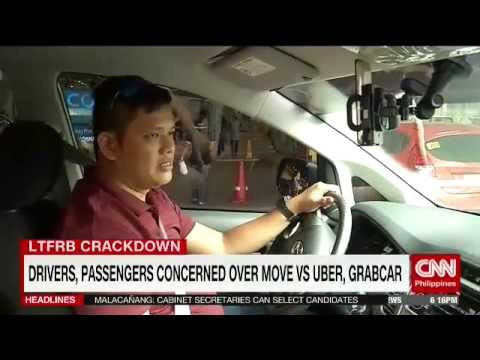
Meanwhile, the Land Transportation Office (LTO) regulations state that in order to carry paying passengers, vehicles must have a commercial license plate, and carry insurance as well as the driver having a professional driving license. Uber drivers being able to continue in the Philippines is as yet uncertain. The costs are not that low either.
Light Rail/Manila Rail
Some parts of Manila are served by an elevated railway system, akin to rapid transit metro. Known locally as LRT-1 (the Green Line that runs north-south) and LRT-2 (the Blue Line that runs east-west), and MRT-3 (the Yellow Line, which runs along the north and south lanes of Epifanio de los Santos Avenue, known locally as EDSA), these three railway lines transport more than 1.25 million passengers a day.
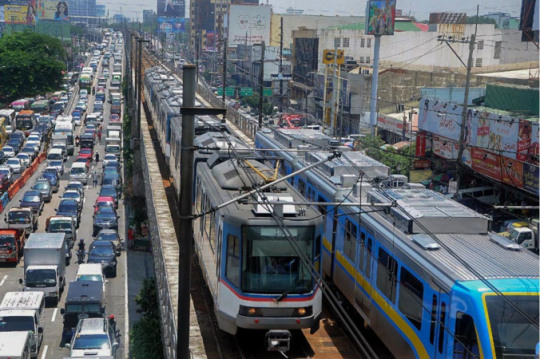
The major benefit of the LRT and MRT lines is the speed at which you can get from one part of Metro Manila to another. With Metro Manila comprising of 16 cities and the municipality of Pateros, this huge metropolis, known collectively as National Capital Region, covers an area of 619.5 km2. To complete the journey along EDSA by bus or car, from south to north, would normally take 4-5 hours, due to the immense volume of traffic.
The main drawback of the LRT and MRT lines is the crowded carriages. No matter what station you get on, chances are you will be standing the entire trip, and crushed up together with hundreds of other commuters.
Jeepney
The first jeepneys were modified army jeeps left behind by the Americans after WWII. They have been customised with Filipino touches such as chrome horses, banks of coloured headlights, radio antennae, paintings of the Virgin Mary and neon-coloured scenes from action comic books, as well as national flags and scenes from different countries, depending on the work location of the Overseas Filipino Worker (OFW) that paid for the jeepney.
Jeepneys form the main urban transport in most cities and complement the bus services between regional centres. The starting fare is usually P8, rising modestly for trips outside the primary distance allowed for that P8 fare. Routes are clearly written on the side of the jeepney, and signs in the windscreen show what locations the jeepney will pass through.
Jeepneys have a certain quirky, cultural appeal, but from a tourist’s perspective, they have one humongous flaw: you can barely see anything through the narrow open slats that pass as windows. The best seats are up front next to the driver.
Again, in most places, jeepneys can fill up fast, especially during rush hours, and sitting cramped with 10 other people on each side of the jeepney is normal. Drivers try to cram as many people in as possible, to get the maximum possible fare, and some passengers are even hanging on to the back, while standing on the step or the rear fender, although this is technically illegal. In more remote areas, it is common for jeepneys to have a roof full of passengers.
I have to say it, jeepneys are one of my favourite forms of public transport here, and I love to commute around the country. Although I can drive, I don’t like to here, and it’s much nicer to let someone else worry about the traffic while we watch the world go by through the small “windows”.
Traysikel
Found in most cities and towns, the traysikel (pronounced try-see-kell) is the Philippine rickshaw – a little, roofed sidecar bolted to a motorcycle. The standard fare for local trips in most provincial towns is P8, which goes up piso by piso the further you get from the pickup point. Traysikels that wait around in front of malls, restaurants and hotels will attempt to charge five to ten times that for a “special” trip, which is like hiring the whole vehicle. Avoid these by standing roadside and flagging down a passing P8 tricycle.
The general rule is, if you flag down a passing traysikel it is single fare only. And they will normally slow down to ask where you are going as they go past. If they don’t, it usually means they are going home or are probably not for hire. Travelling on a traysikel can also be done from a terminal. Just like buses and jeepneys, traysikels have terminals (or should if they are franchised, although some “colorum” traysikels just roam around without the correct plates or licenses picking up passengers along the way). A trip from the terminal, unless you ask for the “special” trip, will cost a single fare.
For example, if I get a traysikel from bayan to the house, it’s P13 if it’s shared. The “special” costs me P52, the price of four normal passengers. Prices can vary from terminal to terminal, so it’s best to always ask the fare before you ride. Traysikels are my other favourite form of public transport here, and the drivers work hard to make enough to feed their families, but they will rarely try and rip you off, even as foreign visitors. If the single fare in your shared traysikel is P8, that’s what you’ll pay.
You can also charter tricycles for about P300 per hour or P150 per 10km if you’re heading out of town.
Pedicabs
Many towns also have non-motorised push tricycles, alternately known as Pedicabs or padyak, for shorter trips. Padyak is a the Tagalog word for stomping or forcefully stepping, which is the action used by the drivers when they are pedaling a pedicab with passengers.
Fares are really cheap, sometimes as much as a few pesos less that traysikels, but they will only go short distances. Many open subdivisions (our kind of housing estate) have Pedicabs at the entrance, as well as dotted around inside, for resident’s convenience.
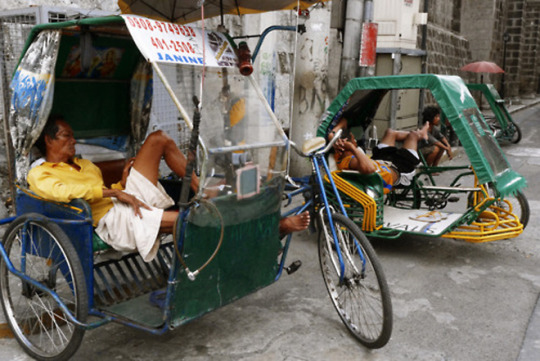
Habal-habal
In the mountain barangays or in the countryside where roads are steep and unpaved, Filipinos always find ways to make things faster and easier to navigate. So, motorcycles are turned into motor-taxis to replace carabaos as a mode of transport.
The normal motorcycle or motorbike is enough only for a passenger and a driver. However, the “habal-habal” motorcycle can carry 2 to 8 passengers (if installed with wooden wings). They are most common in the Visayas and northern Mindanao, although the motorcycle taxi is making inroads in Metro Manila in recent years, just taking only one passenger at a time.
ONLY IN MINDANAO. A motorcycle with 6 passengers ply the Pagalungan highway in Maguindanao province on June 8, 2012 MindaNews photo by Ruby Thursday More
In some areas in the Visayas and Mindanao, “habal-habal” is the term used to call a motorcycle-taxi where the driver and the passengers are in “habal” (animal) position. “Habal” is a Bisayan term that literally means “the sexual (act) intercourse of animals” but now, it seems like the meaning has evolved to mean the mode of transportation… probably due to the “intimate” way passengers are crammed together behind the driver.

Kalesa
A kalesa (also known as caritela or karitela) is a horse-drawn calash used in the Philippines. It was one mode of transportation introduced to the islands in the 18th century by the Spanish, and was initially reserved for only nobles and high-ranking civic officials. These are rarely used in the streets today, except in the tourist-frequented areas of old cities and some rural areas.
A kalesa looks like an inclined cart, and is drawn by a single horse. It has two round wheels on each side and two rows of seats that can accommodate four persons. The driver sits on a block of wood located at the front of the cart near the horse.
Although the kalesa has become a rarity, century-old examples are still preserved in areas of the Philippines, such as in Vigan and Laoag. Kalesas can also be found in Intramuros, where they cater to tourists and Binondo in Manila, as well as in Iligan, where decorated kalesas can be taken for a ride along a specific street. In Cagayan, kalesas are common, especially in Tuao and other municipalities of the province. In Tuguegarao, the carriages are a part of the traffic along with private cars, motorcycles, tricycles, jeepneys, trucks, and bicycles.
Bus & Van
Philippine buses come in all shapes and sizes. Bus depots are dotted throughout towns and the countryside, and most buses will stop if you wave them down. Bus “terminals” also run the gamut. Some are well-secured large garage-like structures with destinations clearly signposted and even ticket booths, whereas others are nothing more than a few run-down outdoor sheds with drivers clamouring for your business. I have even known some locally that are “terminals” in the car park of the local Jollibee or SM Mall.
More services run in the morning – buses on unsealed roads may only run in the morning, especially in remote areas. Night services, including deluxe 27-seaters, are common between Manila and major provincial hubs in Luzon, and in Mindanao.
In NCR, there are normally two kinds of buses. The air-conditioned buses, with closed windows and cool, have their refreshing AC running at close to freezing all the time, while the “ordinary” buses are open, old and amazingly fast. Whereas the AC buses run along the highways almost following the road rules, the “ordinary” buses, which have no air-con except the open windows and rust holes, race along at breathtaking speeds, changing lanes at the drop of a hat, and not slowing down for anyone or anything smaller than them.
While it is nice to ride the AC buses in the hotter weather here, the “ordinary” buses have more character, are cheaper, and often get you there faster, unless it is rush hour in Manila. They look and sound as if they are about to fall apart, but I’ve not ridden on one that has… yet! And when they are going at speed, the open windows give you a cooling breeze, even if it is smog-filled from traffic fumes.
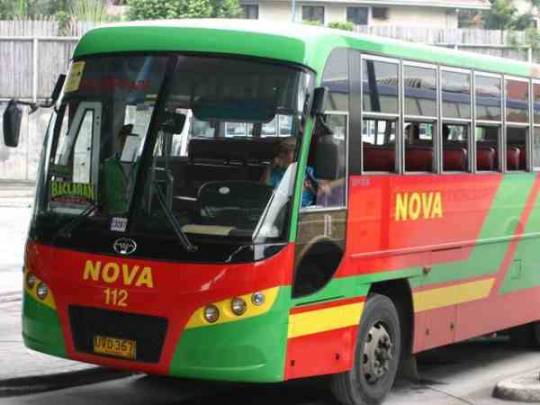
When riding the buses in Manila, especially the “ordinary” ones, be aware of the fares from place to place. It pays to listen to where the people around you are going, to know how much the ride will be, as the conductors will often add a little “surcharge” to foreigners who don’t know the fares. In more than a year of daily trips from Laguna to Makati, I was often told the fare was P10 more than it actually was.
Air-con minivans shadow bus routes in many parts of the Philippines (especially NCR, Bicol, Leyte, Cebu, Palawan and Mindanao) and in some cases have replaced buses altogether. However, you may have to play a waiting game until the vehicles are full. While they are a lot faster, they are not allowed to stop anywhere in Metro Manila, unlike the jeepneys, and there are many that are run illegally, with private use plates instead of commercial plates.
Door-to-door Service
As I mentioned earlier, the Philippines is the only place I know where you can go door-to-door without walking more than a few yards. And I said I would explain how, so here it is.
The best example is going from my house, inside a subdivision, to my wife’s tita (aunt) who lives in Parañaque, Metro Manila.
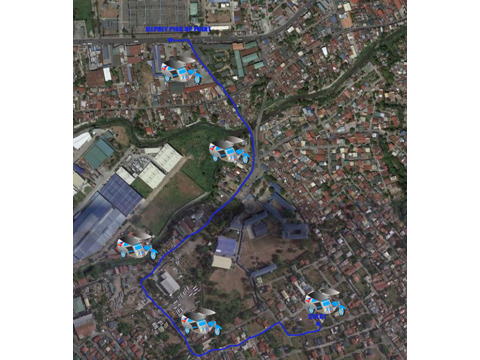
From my house, I can get a traysikel just outside the house to the main highway. Since I live inside a subdivision, a little village of sorts inside the city limits, traysikels often drop passengers off inside, and then go back out. Since they are often not part of the TODA (Traysikel Operators and Drivers Association) for that subdivision or barangay, they cannot go to the nearest terminal, and will pick up roadside passengers along the way, to maximize their income for the trip.
From where I get dropped on the highway, I can get a jeepney across the road to take me to Alabang, in Muntinlupa, which drops off inside Starmall.

The terminal for the buses going all over NCR is right outside, and I can get on one that says “Ayala Ibabaw” on the signs in the windscreen. Conductors are always touting for passengers, and will help with which bus you need to take for people who are not sure.
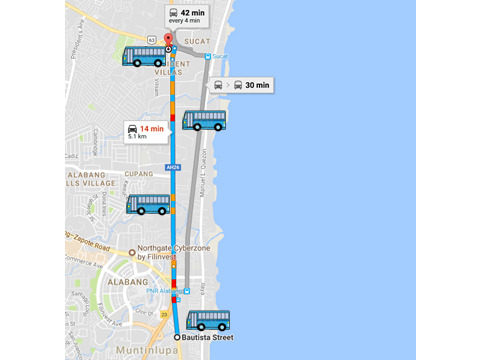
The bus route takes me all the way to Parañaque along SLEX (South Luzon Expressway) and Metro Manila Skyway, and drops off at the Sucat exit.

Cross the road, and I get a jeepney going to San Isidro, which is a single fare price of P8. Get down from the jeepney at the BPI Bank at Greenheights Ave, and cross the road, to the compound where my wife’s tita lives.
The return journey is much the same. A jeepney going past the road outside the compound will take me back down to the Sucat exit, where I can jump on the first bus back to San Pedro, Laguna. Both AC and “ordinary” buses run the route, and there are hundreds of them going that way looking for passengers. (Alternatively, I can get the bus back to Starmall, and do the journey exactly backwards, but I prefer to get a bus all the way to San Pedro.)
At San Pedro, a jeepney passing by can take me into bayan, and drops off around 20 yards from the traysikel terminal for my subdivision. Another P8 fare for this part of the trip.
From the terminal in bayan, the traysikel takes me back to the subdivision, as a shared ride for only P13, and I can direct the driver on which turns to take to get to my house, though since most of them know me from the terminal, I often don’t need to direct them.
What about the other passengers in the traysikel? Well, it’s the norm here for traysikels to carry rideshare passengers (see, we had rideshare and pool vehicles years before Uber!), and there is a courtesy to let the closest one out first, even if it means travelling through many streets to get to your own house after dropping them off.
Another thing that we have with the traysikels is service. Traysikel drivers are some of the nicest people you can meet here, and will gladly carry your shopping bags and sacks of rice to your door, and even inside (if you don’t have nasty, biting dogs like I have), for no extra charge.
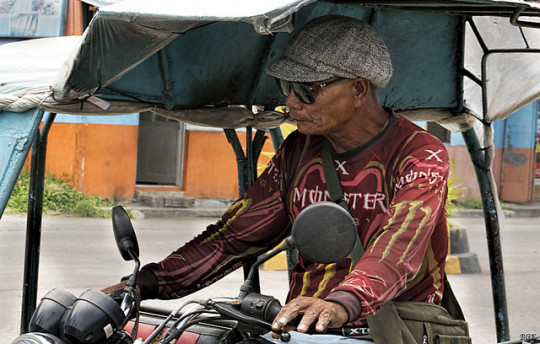
So, if you are thinking of coming to the Philippines, try to travel on the local public transport, and experience commuting the Filipino way. It really is “More Fun in the Philippines”.
Travel in the Philippines – Commuting like a Local Wherever you go around the world, you’re most likely to use public transport at some point. Once you get to the airport, taxis are normally the best option, especially if you have lots of heavy luggage.
#bus#calash#caritela#dolmus#door-to-door#habalhabal#jeep#jeepney#kalesa#karitela#LRT#MRT#ordinary#padyak#pedicab#Philippines#rail#taxi#travel#traysikel#tricycle#uber#UVExpress#van
0 notes